ORC Advanced® Treats Multiple Plumes and High TPH Concentrations
CASE SUMMARY
Past operations at a former U.S. Navy Base in American Samoa had resulted in total petroleum hydrocarbon (TPH) contamination within the subsurface. Currently occupied by an elementary school, the former military base once stored barrels of petroleum-based fuels for military operations. A hydrocarbon sheen was evident following rain events prompting the need for a remedial investigation to determine the extent of contamination within the subsurface. Soil boring samples revealed elevated levels of TPH-diesel, TPH-gasoline, and TPH-motor oil at concentrations exceeding the cleanup standard. Site investigations did not identify any TPH impact to groundwater.
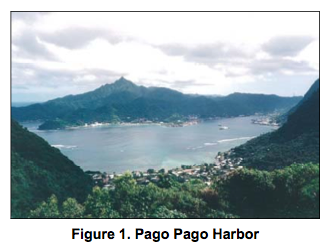
Access to the site and equipment was very limited thus on-site sampling and remediation was conducted only annually when the school was out of session. As a result, a remedial approach was required in which no operations & maintenance would be necessary. In addition, a technology was needed which would not damage on-site structures, successfully treat low permeable soils, and not disrupt the day to day operations of the elementary school. Enhanced bioremediation using ORC Advanced® was chosen since it did not require on-site maintenance and would effectively treat TPH concentrations within a reasonable timeframe.
REMEDIATION APPROACH
The initial application of ORC Advanced® was applied in 2005 via multiple trenches to address the three identified plumes (Figure 4). ORC Advanced® was mixed with water to form a slurry then placed at the bottom of each trench prior to backfilling (Figure 3). Soil sampling one year later indicated a reduction in TPH levels; however three boring samples remained above the cleanup goal. This was explained by the lack of water available in the subsurface to move the ORC Advanced® radially from the applied trench area. A second application in 2006 was delivered via direct-push injection using approximately 2,000 pounds of ORC Advanced® into a total of 82 injection points (Figure 5 & 6). In 2007, an ORC Advanced® injection application was completed to treat the few remaining hot spots. One last application is scheduled for summer 2008.
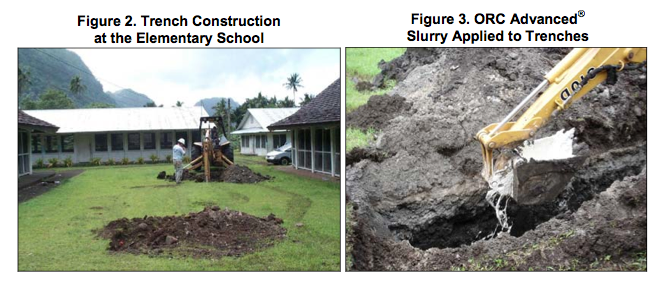
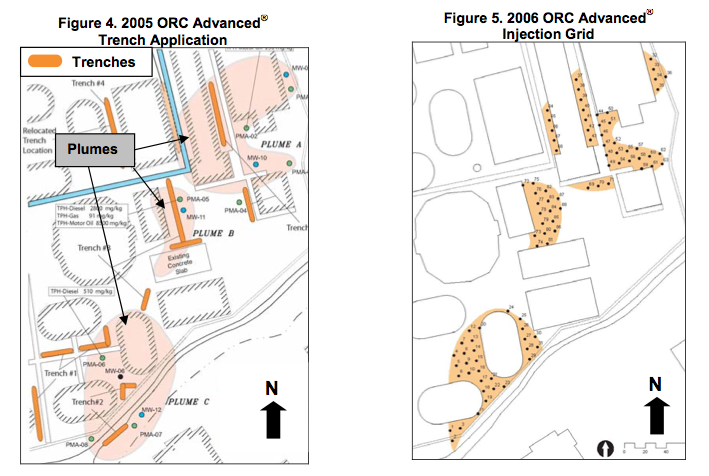
RESULTS
Trench Application
The 2005 trench application was successful in reducing TPH concentrations significantly (Table 1). Within the area of highest concentrations (PMA-05), TPH-diesel was reduced from 2,800 milligrams per kilogram (mg/kg) to 1,700 mg/kg, TPH-motor oil declined by 50% and TPH-gasoline was reduced to below the cleanup goal of 50 mg/kg. Of the eight sampled areas, three remained above the Project Action Level – PMA-01, PMA-02, and PMA-05. Although the trench application was successful in reducing concentrations within the immediate application area, the radius of influence was not great enough to remediate the entire plume. Therefore, a follow up application was designed using direct-push technology.
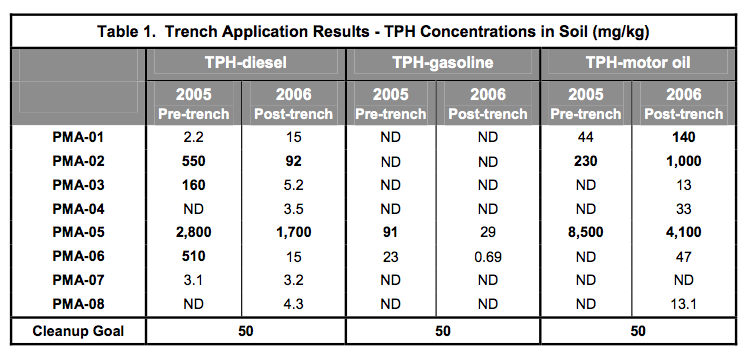
Direct-Push Application
The direct-push application substantially reduced high concentrations of TPH-diesel and TPH-motor oil (Table 2). Most significant was area PMA-05 where TPH-diesel declined from 1,700 mg/kg to below the cleanup goal and TPH-motor oil was reduced from 4,100 to 120 mg/kg, a 97% reduction. An increase in concentrations was observed as a result of the direct-push technique which mobilized residual contamination from the soil. A direct-push injection was completed in July 2007 to address the remaining concentrations of TPH-diesel and TPH-motor oil. A total of 2,500 pounds of ORC Advanced® were applied using the same design layout as the 2006 application (Figure 5). One last application is planned for summer 2008.

CONCLUSION
To date, one ORC Advanced® trench application and two direct-push injections have been completed. The trench technique was effective within the immediate vicinity of the application. However, in order to achieve a better radius of influence, the direct-push technique was more effective. Additionally, the impact and inconvenience to the site from direct-push was significantly less in comparison to the large trenched areas as shown in Figures 2 and 3.
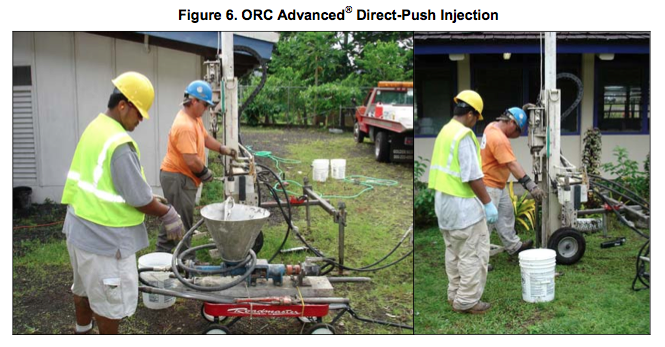
TPH-motor oil has remained above the cleanup goal as seen in Table 2. This can be explained by the fact that the molecular size of motor oil is more significant compared to diesel and gasoline and, therefore, more time is needed to breakdown the molecule. In addition, as a result of the injection, mobilization of residual contamination from the soil caused an increase in concentrations. The July 2007 application is expected to continue the breakdown of any remaining contamination, including motor oil, towards the cleanup goal. Sampling will again be completed in the summer of 2008 along with one final ORC Advanced® application.
Combined RegenOxTM and ORC Advanced® Application Treats TPH and BTEX
Introduction
Operations at a former car dealership resulted in petroleum hydrocarbon contaminated soil and groundwater. In the source well SB7, groundwater concentrations of total petroleum hydrocarbons (TPH) had increased to 250 parts per million (ppm) and concentrations of benzene, toluene, ethylbenzene, and xylenes (BTEX) were present at more than 400 ppm. In order to reach the TPH site specific target level (SSTL) of 19.2 ppm, a combined remedial approach using chemical oxidation and enhanced aerobic bioremediation was implemented. Injections of RegenOxTM and ORC Advanced® were applied in four separate injection events (Table 1). The combined approach was designed to treat the high concentrations and promote aerobic bioremediation of any remaining residual contamination.
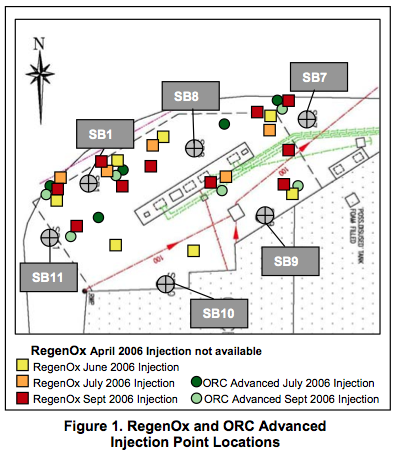
Remediation Approach
The remedial objective was to reduce high concentrations of TPH to below the SSTL of 19.2 ppm. RegenOx was applied in April 2006 and June 2006 across the plume (Figure 1). Both RegenOx and ORC Advanced were applied separately in July 2006 and September 2006. (Table 1)

In Situ Treatment Results
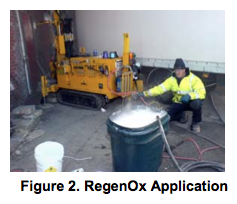 Shortly after the initial RegenOx chemical oxidation treatment, TPH was reduced by an average of 67% (Graph 1). As is typical following the first chemical oxidation application, contaminant rebound occurred after approximately one month. This is primarily a result of rapid desorption of sorbed phase contaminants from soil into groundwater and the 30 day longevity of RegenOx. Three follow up RegenOx injections were applied to continue treatment and eliminate the remaining contamination. Additionally, two ORC Advanced injections were performed to provide a long-term (12 months on average) oxygen source for enhanced aerobic bioremediation.
Shortly after the initial RegenOx chemical oxidation treatment, TPH was reduced by an average of 67% (Graph 1). As is typical following the first chemical oxidation application, contaminant rebound occurred after approximately one month. This is primarily a result of rapid desorption of sorbed phase contaminants from soil into groundwater and the 30 day longevity of RegenOx. Three follow up RegenOx injections were applied to continue treatment and eliminate the remaining contamination. Additionally, two ORC Advanced injections were performed to provide a long-term (12 months on average) oxygen source for enhanced aerobic bioremediation.
RegenOx was effective at reducing TPH to below the SSTL in all wells, excluding SB7 (Graph 1) which was located within the source area. However, a reduction of 95% occurred in SB7 within two weeks of the initial RegenOx injection. Rebound was observed in this area throughout the treatment, indicating that sorbed phase TPH was more prevalent around this well. RegenOx reduced the overall TPH loading of the soils and maintained TPH concentrations in groundwater to below 60 ppm. The ORC Advanced applications are expected to further TPH reduction in this area via enhanced aerobic biostimulation beyond the length of the monitoring program.
Conclusion
As a result of the RegenOx applications, concentrations were reduced quickly and cost-effectively within weeks of the injections. It is expected that the remaining concentrations above the SSTL in Graph 1 will be reduced as ORC Advanced continues to release oxygen. Successful closure was achieved due to the overall reduction in TPH concentrations, the observed reduction in contaminant concentrations in the source area, and the expected future reductions from the application of ORC Advanced.
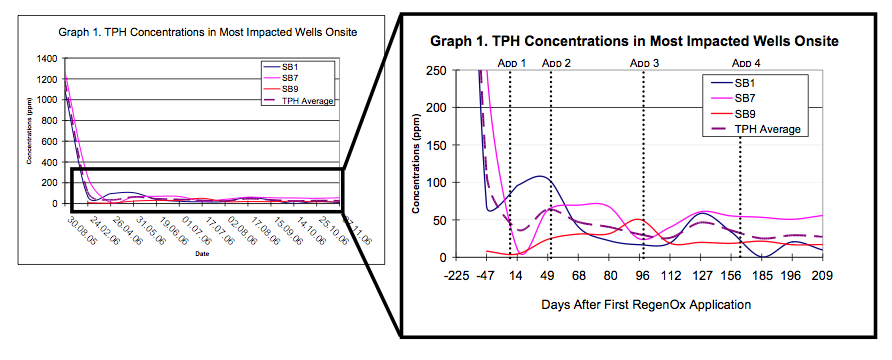
RegenOx® Treats Benzene in Low Permeability Soils
Introduction
Service station operations created a benzene contaminant plume in tight subsurface soils. A dual-phase extraction system (DPE) was installed and removed a total of 9,965 pounds of petroleum hydrocarbons over two 90-day operational periods. However, contaminant removal reached asymptotic levels and a more effective remedial strategy was needed to address the remaining benzene concentrations. The DPE system was shut down in December 2004 and RegenOx® was selected to evaluate the effectiveness of reducing benzene and MTBE concentrations in tight soil lithology.
Description of Activities
RegenOx was pilot tested around well DPRW-6 to evaluate its effectiveness in tight soil. A total of 1,439 pounds of RegenOx was applied near well DPRW-6 as a pilot test in August 2005 (510 lbs) and July 2006 (929 lbs). Benzene concentrations declined within 15 weeks by 76% and successfully reached the Site Specific Target Level (SSTL) (Graph 1), prompting a design for full scale implementation.
The objective of full-scale treatment was to provide rapid mass reduction of benzene concentrations and reach the SSTL of 20.1ppm across the 9,100 ft2 source area. Benzene rebound at DPRW-6 (the original pilot test well) six months post-injection suggested that a previously unidentified plume had re- contaminated that area. After additional site characterization was completed, 7,110 pounds of RegenOx were applied during six injection events over five treatment areas (Figure 1).
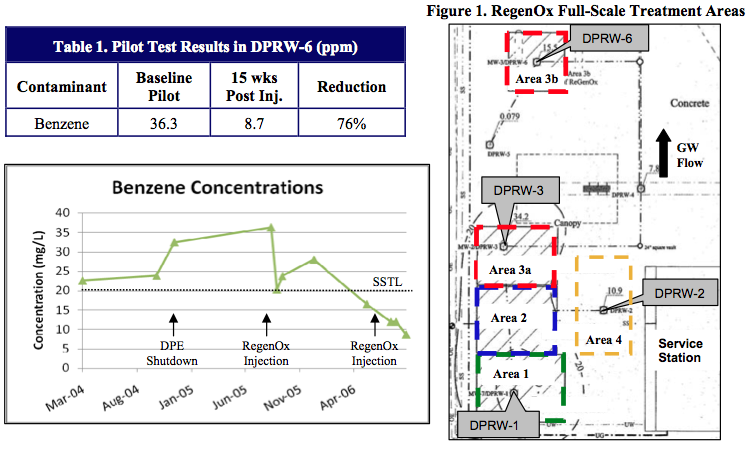

The RegenOx injections were performed over a 6 month period due to weather delays. Monitoring was conducted to observe potential contaminant rebound from areas requiring additional injections. The applications targeted a treatment thickness of 14-20 feet bgs into silty clay with intermittent sand “stringers”. RegenOx was injected using a top-down direct-push injection technique with 5-15 lbs of RegenOx injected per vertical foot.
Results
Prior to the full-scale application, benzene concentrations exceeded the SSTL of 20.1ppm in all wells. Monitoring over a 7 month period prior to remedial treatment indicated an increase in concentrations from 12 – 32ppm to 20.4 – 44.1ppm.
RegenOx was applied over six injection events as indicated in Table 2. Sampling conducted
after the final application event in December 2007 indicated a benzene reduction to at or below the SSTL in all wells (Graphs 2) including the original pilot test well DPRW-6. As monitoring continued, a decline in benzene concentrations persisted via natural attenuation and all wells sampled below 10ppm in August 2009. Based on the reducing trend observed over the past 12 months, the site was recommended for closure.
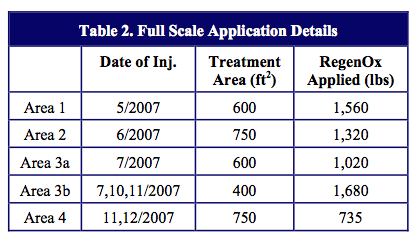
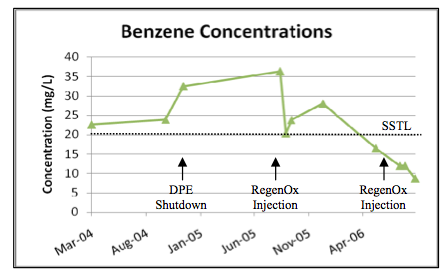
DOD Treatability Study Documents Successful Carbon Tetrachloride Remediation using HRC®
Contaminant Concentrations Reduced by 99% Within One Year
Project Highlights
- Treatability study demonstrated effective reduction of carbon tetrachloride and benzene contamination
- Combined application of HRC® and HRC Primer® reduced carbon tetrachloride concentrations to below cleanup goal within one year
- Influx of additional carbon tetrachloride contamination to the site was buffered by enhanced anaerobic bioremediation
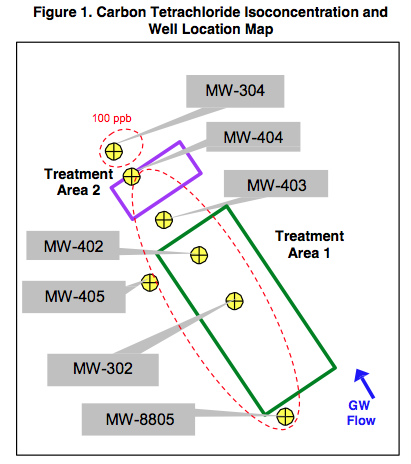
Project Summary
Historic operations at a Department of Defense site in Maryland resulted in soil and groundwater contamination with carbon tetrachloride, benzene, and chloroform at concentrations of 274 μg/L, 178 μg/L, and 21 μg/L, respectively. Monitoring at the site revealed decreasing trends in contaminant concentrations as a result of natural attenuation. However, the site was on a redevelopment schedule and monitored natural attenuation was deemed to be too slow and costly.
The Air Force, in conjunction with the Comprehensive Environmental Response, Compensation, and Liability (CERCLA) Partnering Team, agreed to perform a treatability study to observe the effectiveness of enhanced anaerobic bioremediation to reduce the contaminants. A focus was placed on the biodegradation of carbon tetrachloride due to its highly recalcitrant nature; if it could be treated, so could the other constituents, such as benzene1. Although benzene is commonly degraded under aerobic conditions, the destruction of the contaminant has also been known to occur under anaerobic conditions.1
A mixture of HRC and HRC Primer was applied to the contaminated site to establish optimal reducing conditions in groundwater and thereby enhance the process of reductive dechlorination. Direct-push injections were applied in a grid pattern within the two treatment areas shown in Figure 1. Groundwater monitoring was conducted in and around the treatment areas to evaluate the distribution and treatment effectiveness.
Technology Description
HRC is an engineered, hydrogen release compound designed specifically for enhanced, in situ anaerobic bioremediation of chlorinated compounds in groundwater or highly saturated soils.
HRC Primer is derivative of the standard Hydrogen Release Compound (HRC) product and is designed to provide a controlled but fast release of hydrogen to assist in initiating anaerobic biodegradation.
Results
Carbon Tetrachloride Reduced up to 99% After 3 Months
Sampling results three months after the HRC/HRC Primer injection revealed carbon tetrachloride reductions of 87% – 99% within the treatment areas. Downgradient wells MW-403 and MW-304 were also affected by HRC, with carbon tetrachloride concentrations declining below the maximum contaminant level (MCL) of 5 μg/L. Continued reductions in the HRC-affected wells were observed over the following year, with levels dropping below the cleanup goal in 5 of the 6 wells. (Graph 1).
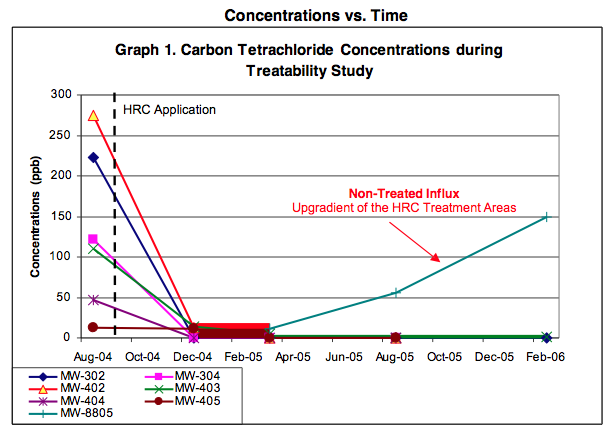
During the same sampling period, a continuous increase in the concentration of carbon tetrachloride was observed in well MW-8805 upgradient of the treatment areas. This increase is indicative of an influx of additional contamination to the area, which is assumed to have also occurred within the nearby treatment areas. Importantly, the contaminant levels within the HRC-affected wells remained below 5 μg/L during this period, indicating the effective treatment of both resident and influx carbon tetrachloride.
Benzene Concentrations Declined Up To 98%
Baseline benzene concentrations exceeded 150 μg/L prior to the treatability study. Reducing conditions were established shortly after the HRC/HRC Primer injection, and concentrations declined 56% – 98% over the following 18 months. Concentrations are expected to reach the cleanup goal of 5 μg/L as HRC continues to be effective in the subsurface.
Chloroform Concentrations Reduced to Cleanup Standards
Initial chloroform concentrations were above 20 μg/L. Six months post-HRC application, 3 out of the 6 HRC-treated wells sampled below the MCL of 0.15 μg/L. Within 12 months, the cleanup goal was reached in all wells except MW-403 (2.3 μg/L).
1 In the presence of certain microbes, Dechloromonas strain RCB and strain JJ, Benzene can be degraded anaerobically (Coates, J. D., Chakraborty, R., Lack, J. G., O’Connor, S. M., Cole, K. A., Bender, K. S., Achenback, L. A. “Anaerobic Benzene Oxidation Coupled to Nitrate Reduction in Pure Culture by Two Strains of Dechloromonas.” Nature June 28, 2001: 1039-1043.)
Rapid Reduction of Petroleum Hydrocarbons using ORC Advanced® allows for Redevelopment of Site
Summary
Remedial works at the Former Lama Petroleum site were undertaken in late 2008 as part of the ongoing redevelopment of the Fresh Wharf Estate in Barking UK. The site was to be developed for light industrial use, however, historical oil mixing handling and storage activities performed on the site had resulted in TPH and PAH contamination in the groundwater.
Site investigation works suggested the presence of an approximately 1,000m2 source area in thenorthwestern portion of the site, as well as a downgradient plume area, estimated to be in the region of 6,000m2 extending towards the Handtrough Creek. Phase separated hydrocarbons were detected in the source area where the former above ground storage tanks had been located prior to decommissioning circa 2003. In the downgradient plume area, the maximum dissolved phase TPH concentration was 1,100μg/L (Monitoring Well BH102) and located adjacent to Handtrough Creek.
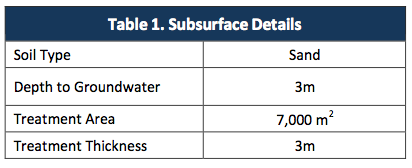
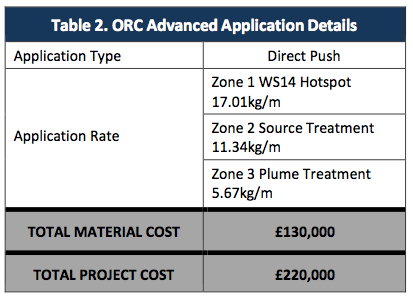
Remedial Strategy
The remedial objective was to reduce dissolved phase concentrations of Total TPH and PAH in groundwater to the agreed remedial target level of 110μg/L, within 12 months of treatment. A trigger level for further remediation was set at 200μg/L, equating to an 80% contaminant concentration reduction within 42 weeks post treatment. If the trigger TPH concentration was not achieved within 42 weeks after treatment, further options would be undertaken.
The original assessment of remedial options identified that a combination of Pump and Treat (P&T) to target free product in the source area and ORC Advanced® treatment in the groundwater plume would represent the most time‐efficient and cost‐effective remedial solution for the site. However, trial pits advanced in the source area during site clearance works
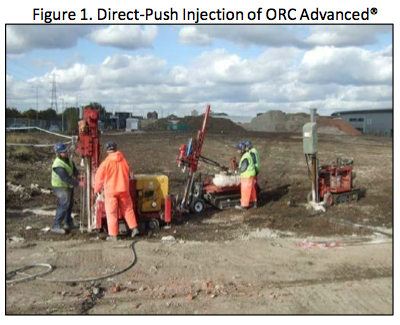
determined that free product was not present in the groundwater, but was present in discrete bands within the unsaturated made ground. Following this observation, excavation to remove the most impacted soils in the source area was determined to be the most suitable approach and P&T was discarded as an option.
Soil removal works were undertaken at the site in October 2008. ORC Advanced treatment in both the source and plume areas was undertaken in October and November 2008. ORC Advanced was applied using three direct push injection rigs and a separate mixing and pumping unit. The rods were driven to 6mBGL and the ORC Advanced was applied over the impacted saturated zone as the rods were slowly withdrawn to 3mBGL. The application included a total of 813 injection points over 19 drilling days. The dose rates were varied to match the different contaminant concentrations and conditions encountered across the site (Tables 1 & 2). Vibro‐piling works were completed across the site at the same time as the ORC Advanced was being applied and were unimpeded by the direct push equipment.
Results
Following the injection of ORC Advanced, a slight increase in the dissolved phase contaminant concentrations was observed due to the site disturbance from injection and piling works. Both TPH and PAH concentrations then rapidly decreased to below the site specific remedial target values and remained low over the monitoring programme. A 99% reduction in the groundwater concentrations of TPH and PAH was achieved with no rebound. Monitoring results are presented below for well BH102, which was located on the southern site boundary, adjacent to Handtrough Creek.

Conclusion
Following the application of ORC Advanced, TPH and PAH concentrations were rapidly reduced and maintained below the site specific target values without contaminant rebound. The works were completed safely and efficiently and did not hinder the ongoing construction works occurring simultaneously at the site. The low final contaminant concentrations and the lack of rebound resulted in regulatory acceptance of the remediation and development works were completed.
Replacement of P&T with ORC Advanced® Reduces Cost to Closure
CASE SUMMARY
Two leaking underground storage tanks (USTs) resulted in soil and groundwater contamination at a service station in Michigan. Naphthalene, trimethylbenzene (TMB) and benzene, toluene, ethylbenzene, and xylenes (BTEX) contamination were discovered in the subsurface prompting the need for remedial cleanup. Michigan DEQ began remediation via UST removal and soil excavation. A total of 4,000 cubic yards of contaminated soil was removed. A pump and treat (P&T) system was installed and operated for 8 years through November 2003. The system removed 1,575 pounds of BTEX and significantly lowered contaminant concentrations. However, the P&T system reached asymptotic conditions and would not be effective in achieving site closure goals. Regulators began looking into new ways of accelerating the remediation process and reducing the overall cost of cleanup. Enhanced aerobic bioremediation using ORC Advanced® was deployed to replace the P&T system and degrade the remaining contamination.
REMEDIATION APPROACH
The remediation objective was to continue the reduction of petroleum hydrocarbons in the subsurface and reduce the cost to closure. Three months after the P&T was shutdown an ORC Advanced application took place. The ORC Advanced injection included 43 injection points in a grid design within the contaminated area surrounding well MW-9 (Figure 1).
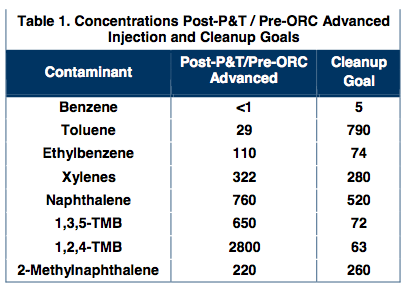
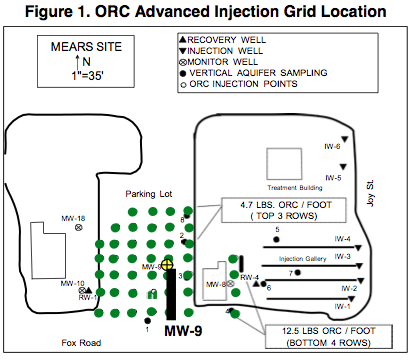

RESULTS
Pump & Treat Results
An increase in rainfall during certain parts of the remedial period contributed to some of the increases observed in Graph 1. During wet periods, an increase in concentrations resulted from the mobilization of contaminants within the capillary fringe smear zone. An infiltration gallery was installed to flush the contamination into the dissolved-phase where it was available for P&T removal.
Prior to shutdown in November 2003, O&M costs were increasing and low-level dissolved- phase concentrations were still elevated indicating the system was not effective at reaching the required low cleanup levels.
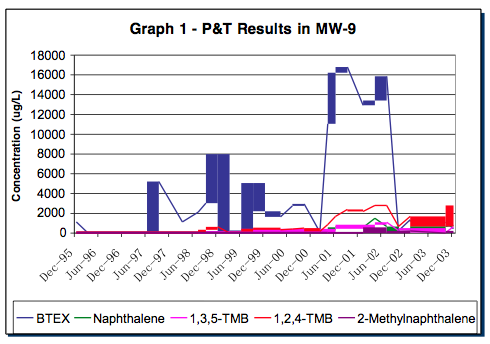
ORC Advanced Injection Results
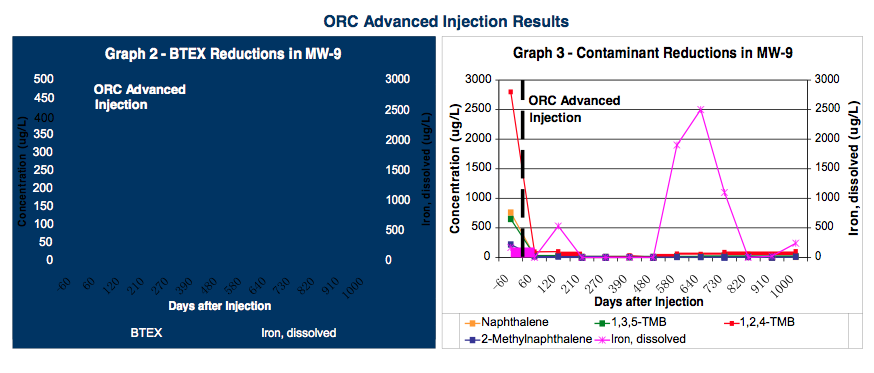
ORC Advanced Injection Results
Within 60 days of the ORC Advanced application, low-level concentrations were significantly reduced below post-P&T levels. Reduction continued throughout the monitoring period and a 99% mass reduction was achieved approximately 13 months after the initial injection. In well MW-9, concentrations in all contaminants were reduced to below the cleanup goals.
The ORC Advanced application eliminated increasing O&M costs of an aging P&T system and allowed the site to be closed years ahead of projections.
High Benzene Concentrations Reduced Using ORC Advanced
SITE SUMMARY
Elevated levels of petroleum hydrocarbons were discovered near the former dispenser island at a former service station in Sheboygan, WI. In hopes of reducing concentrations, soil excavation activities took place in June 2003. A total of 500 tons of hydrocarbon-impacted soils were removed and transported to a landfill for disposal. However, residual contamination continued to affect the groundwater after the excavation. By March 2004, benzene and ethylbenzene had risen to 2,500 ug/L and 1,300 ug/L, respectively. In Situ bioremediation using ORC Advanced was chosen to reduce BTEX, naphthalene, and trimethylbenzenes. In the northwest corner of the site, the location of the former UST basin, a total of 480 pounds of ORC Advanced was injected. In the southeast corner, the area of highest contamination, a total of 2,370 pounds of ORC Advanced was injected.
REMEDIATION APPROACH
- Remediation Objective: Reduce concentrations of Benzene to cleanup goals at the entire site. See Table 1.
- Application Type: Grid
- Product: ORC Advanced
- Quantity Applied: 2,850 lbs
- Application Rate: NW Corner–4 lbs/ft; SE Corner-11.9 lbs/ft
- Injection Spacing: 10 ft
- Product Cost: $24,225
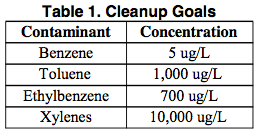
SITE CHARACTERISTICS
- Name: Former Marathon Unit #3697
- Location: Sheboygan, WI
- Industry: Service Station
- Contaminants of Concern:
Hydrogeology
- Treatment Area: NW Corner 1,200 ft2; SE Corner 1,800 ft2
- Soil Type: Silty sand lenses in clay matrix
- Groundwater Flow Direction: Southeast
- Depth to Groundwater: 12-15 ft
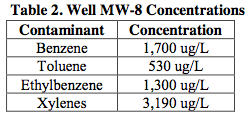
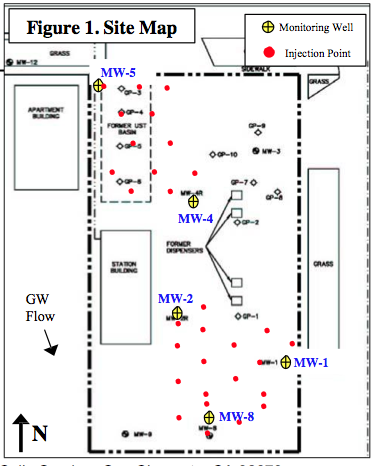
RESULTS
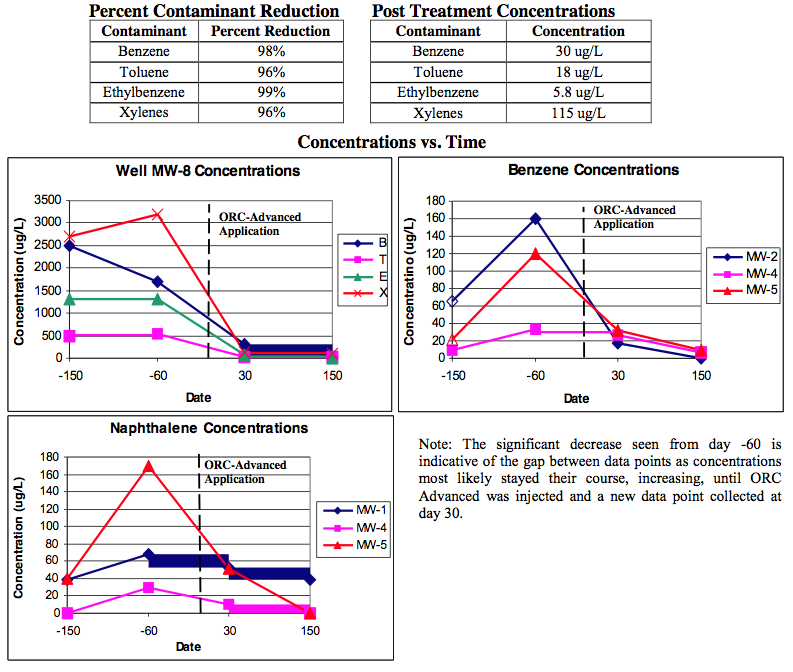
CONCLUSION
Groundwater sampling results after excavation activities show an increasing trend of contamination. On average, concentrations continued to increase up until the ORC Advanced application due to residual contamination. Concentrations peaked before ORC Advanced injection followed by a significant reduction across the plume. In well MW-5, benzene spiked to 160 ug/L while naphthalene rose to 170 ug/L and in well MW-4 BTEX, naphthalene and trimethylbenzenes all increased. Significant decreases of all contaminants were seen shortly after ORC Advanced injection. In well MW-8 total BTEX was reduced from 6,720 ug/L to 168.8 ug/L, a 97% reduction. Naphthalene concentrations were above the MCL of 20 ug/L in wells MW-1, MW-4, MW-5. ORC Advanced reduced concentrations to non-detect in wells MW-4 and MW-5, leaving 38 ug/L in well MW-1. Monitoring is on-going as concentrations continue to decrease towards MCLs.
Surgical Site Closure – 30 Sites in Indiana Receive Closure using ORC
CASE SUMMARY
Surgical Site Closure
The “Surgical Site Closure” strategy was developed by Mr. Steve Sittler, an employee of KERAMIDA in Indianapolis, Indiana. The method is an innovative remedial strategy designed to intelligently integrate natural attenuation, risk-based cleanup goals and focused source removal/treatment to cost-effectively remediate contaminated areas. This approach is best applied at sites where released materials are amenable to biodegradation and where long-term, natural attenuation-type strategies are not suitable for reasons of property transfer or potential off-site liability. This strategy was performed at 30 sites in Indiana for a major oil company.
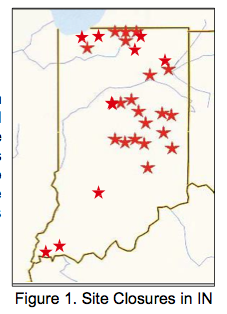
Service Stations/Bulk Storage Terminals – Indiana
From 1998-2008, a total of 30 service station/bulk storage terminal sites were targeted for Surgical Site Closure in Indiana. The subsurface matrix consisted of unconsolidated sediments ranging from low-permeability silty clays with sand stringers to sand and gravel formations. The contaminants of concern were primarily gasoline and diesel fuel. A combination of source removal via excavation coupled with enhanced in situ bioremediation using Oxygen Release Compound (ORC®) was performed at most sites.
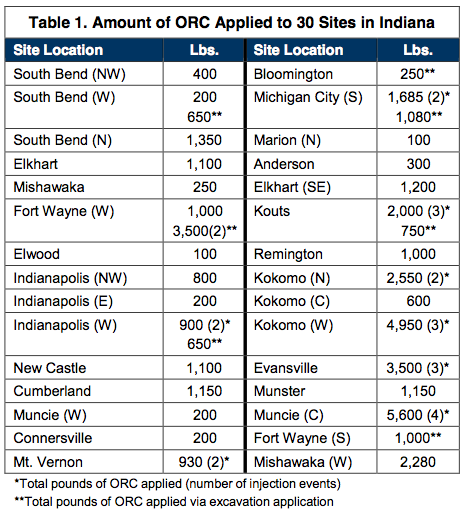
REMEDIATION APPROACH
The remediation approach included focused soil excavation of the source area and/or ORC direct-push injection. At some sites ORC was applied to the base of the excavation prior to backfilling. Shortly afterwards, a direct-push injection of ORC was completed over the remainder of the plume. The amount of ORC needed at each site location was determined using various site characteristics including contaminant concentration, seepage velocity, and treatment area.
The majority of the sites were successfully treated using only one injection of ORC; however, a handful of sites received multiple applications. Most of these sites indicated that high levels of BTEX were present prior to treatment (>1,000ppb to <50,000ppb) and required additional applications to sustain aerobic bioremediation.
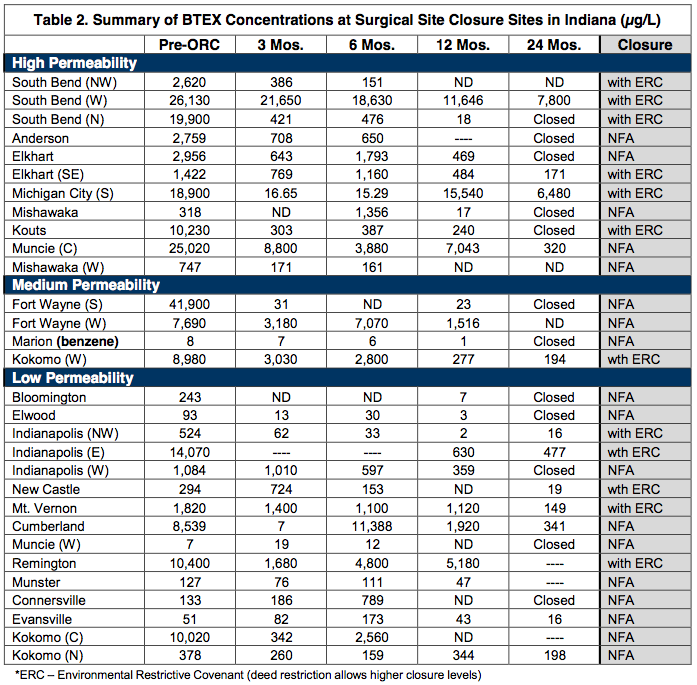
ABOUT THE CONSULTANT
![]() KERAMIDA Inc. is an engineering and consulting firm that serves industries, businesses, cities, and governments worldwide. They provide strategy and implementation services in: Sustainability, Green House Gases, Energy, Environmental Compliance, Remediation, Environmental Due Diligence, Brownfield Redevelopment, Plant Decommissioning, Health & Safety, Training, Risk Management, and ISO Management Systems. Established in 1988, KERAMIDA is headquartered in the historic Lockerbie Square district of Indianapolis, Indiana. The firm employs over 70 technical experts and support personnel in offices throughout the U.S., including Chicago, IL; Pittsburgh, PA; New York, NY; Los Angeles, CA, Sacramento, CA. KERAMIDA’s many principals have worked for over 25 years in the sustainability, environmental, health & safety, and remediation arenas, and are recognized leaders in their fields. Their engineers, scientists, and planners are renowned for delivering creative, integrated EHS solutions to a broad range of clients throughout the U.S. and abroad.
KERAMIDA Inc. is an engineering and consulting firm that serves industries, businesses, cities, and governments worldwide. They provide strategy and implementation services in: Sustainability, Green House Gases, Energy, Environmental Compliance, Remediation, Environmental Due Diligence, Brownfield Redevelopment, Plant Decommissioning, Health & Safety, Training, Risk Management, and ISO Management Systems. Established in 1988, KERAMIDA is headquartered in the historic Lockerbie Square district of Indianapolis, Indiana. The firm employs over 70 technical experts and support personnel in offices throughout the U.S., including Chicago, IL; Pittsburgh, PA; New York, NY; Los Angeles, CA, Sacramento, CA. KERAMIDA’s many principals have worked for over 25 years in the sustainability, environmental, health & safety, and remediation arenas, and are recognized leaders in their fields. Their engineers, scientists, and planners are renowned for delivering creative, integrated EHS solutions to a broad range of clients throughout the U.S. and abroad.
CONCLUSION
The Surgical Site Closure method was successful in reaching site closure at 30 petroleum-impacted sites over a nine-year period. The average time to reach site closure was ~3 years and the average cost to implement the remedial strategy was ~$70,000. Cost analyses indicated that a traditional remediation approach would have ranged from at least $100,000 to potentially $1 million. Actual implementation costs for the Surgical Site Closure approach ranged from approximately $25,000 to $75,000 plus monitoring costs.
Successful Pilot Test Results in Full-Scale Treatment of Large BTEX Plume
CASE SUMMARY
Refueling Station – Algonquin, IL
Leaking underground storage tanks at a refueling station resulted in a benzene, toluene, ethylbenzene and xylene (BTEX) plume in the underlying sand/gravel aquifer. The plume covered 1-acre and extended 390 feet downgradient from the source area, with a total BTEX concentration exceeding 24,000 parts per billion (ppb). In an effort to mitigate the source, 795 cubic yards of contaminated soil was excavated; however, further groundwater monitoring revealed that BTEX concentrations still exceeded the Illinois EPA cleanup levels. To address the remaining contamination and reduce concentrations to the state cleanup goal, a remediation plan was implemented using Oxygen Release Compound (ORC®) and ORC Advanced®.
REMEDIATION APPROACH
The remediation objective was to reduce petroleum hydrocarbon contamination, mainly benzene, to the state cleanup goal. A pilot test was performed using ORC to observe the effectiveness of reducing BTEX concentrations. Successful reduction was achieved within 4 months and a full-scale application was implemented. The full-scale application was focused near the source area as well as within the mid-plume area (near MW-7 & MW-8). Two applications followed within the mid- and lower plume areas to continue BTEX reduction.
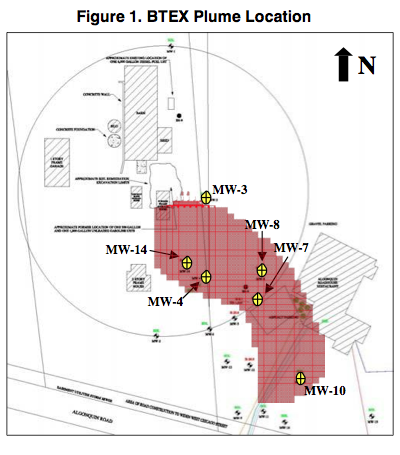
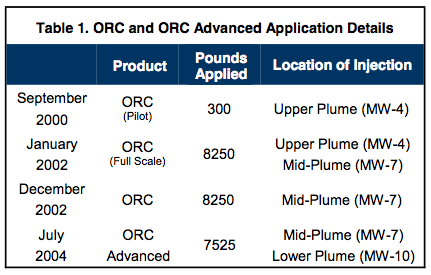

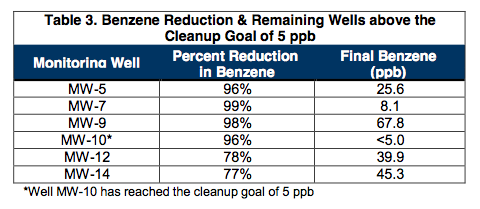
- Application Type: Grid & Barrier Application
- Soil Type: Clay above Sand/Gravel
- Groundwater Velocity: 0.25 ft/day
- Treatment Area: 43,500 ft2
- Injection Spacing: 10–20 feet
- Product Cost: $171,600
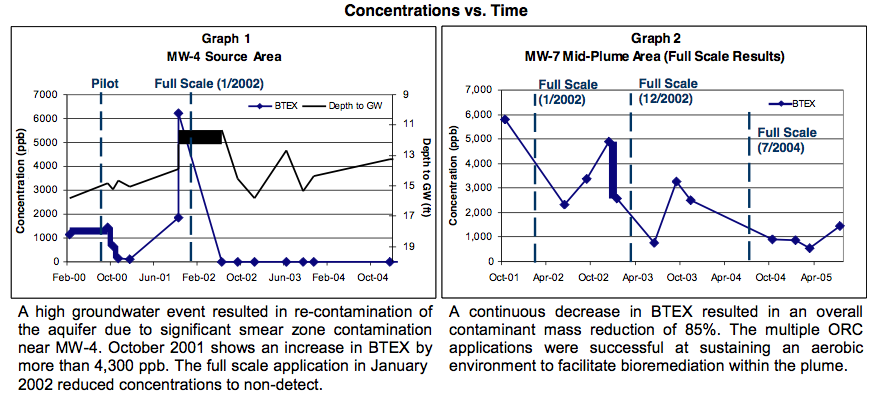
Five of the ten contaminated monitoring wells achieved the remedial objective for benzene as well as all other contaminants following the ORC and ORC Advanced injection. Benzene reduction for those wells that have not yet achieved the cleanup goal are listed in Table 3. Overall, a benzene mass reduction of over 95% was achieved. It is expected that the remaining contaminant concentrations will reach cleanup goals as monitoring continues.
Site Closure Sought after using ORC® Biobarrier to Enhance Aerobic Biodegradation of MTBE and TPHg
CASE SUMMARY
Former Service Station – Bishop, CA
Extensive methyl tertiary-butyl ether (MTBE) and total petroleum hydrocarbons as gasoline (TPHg) contamination was discovered within the subsurface as a result of leaking underground storage tanks (USTs) at a former service station. Following the removal of the leaking USTs, a total of 1,192 cubic yards of gasoline- impacted soil in the source area was excavated and transported off-site for treatment. Monitoring following the excavation activities revealed residual source contamination found in the capillary fringe immediately downgradient near Wells MW-6 and MW-7. Concentrations in Well MW-6 exceeded 7 parts per million (ppm) MTBE and approximately 11 ppm TPHg. Efforts to further delineate the plume revealed petroleum contamination extending 1,700 feet downgradient from the source. Early efforts were made to treat the downgradient plume utilizing an air sparging/vapor extraction system placed 800 feet downgradient from the site of the original release. This approach proved to be effective as MTBE and TPHg were reduced to non-detect levels downgradient from where it was installed. However, the source area continued to reveal MTBE and TPHg concentrations above the cleanup goals enforced by the California Regional Water Quality Board. To treat the source area and bring the site to closure, an enhanced bioremediation barrier (biobarrier) was designed and implemented using Oxygen Release Compound (ORC®).
REMEDIATION APPROACH
To address the source area, a total of 950 pounds of ORC was mixed with water to form a slurry and injected via direct-push technology. The 3 row ORC biobarrier was applied immediately downgradient from the release area (Figure 1). Wells MW-6 and MW-7 were monitored to observe the effectiveness of ORC.
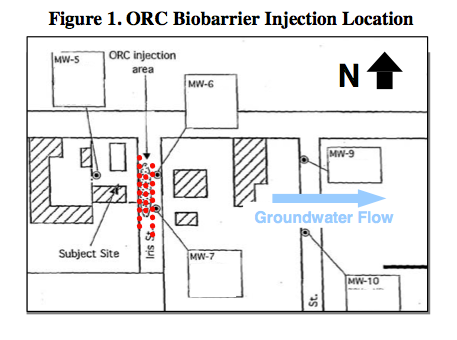
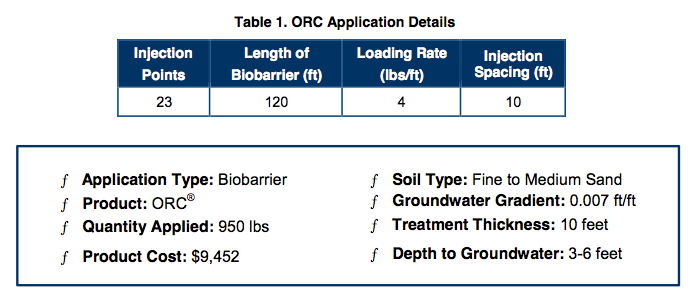
RESULTS
The post-ORC injection monitoring results show an effective reduction of MTBE and TPHg within one year. Well MW-6 indicates two MTBE concentration spikes likely caused by residual contamination from the soil entering into the groundwater (Graph 1). However, an MTBE reduction of 94% occurred between day 210 and 300 and concentrations reached non-detect shortly afterwards. TPHg concentrations declined by 70% within the first 30 days and continued on a downward trend, reaching non-detect levels approximately one year after the application.
In Well MW-7, reduction occurred immediately after injection with an MTBE decrease of 88% by day 120 (Graph 2). Concentrations reached non-detect less than a year after the ORC application. TPHg levels declined similarly to MTBE and reached non-detect in less than one year.
The effective treatment of MTBE and TPHg using ORC resulted in non-detect levels of both contaminants and has allowed the consultant to seek site closure status from the regulatory agency.
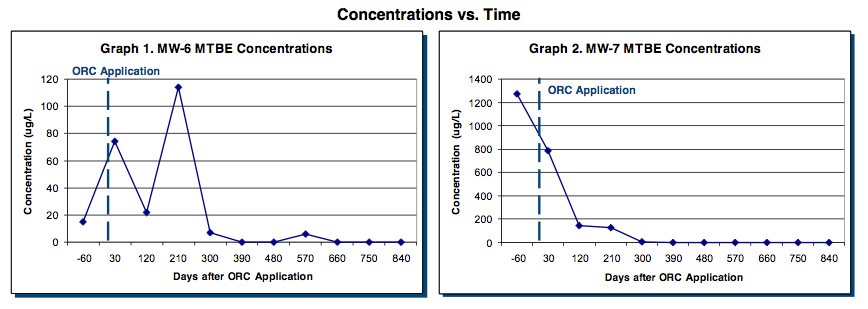

 Americas
Americas Europe
Europe Français
Français Deutsch
Deutsch Italiano
Italiano Español
Español

